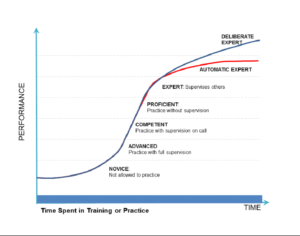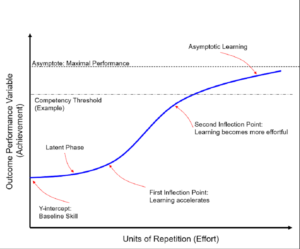Admin note: This blog is Part 1 in a series! See the end of this post for the upcoming topics.
—————————-
By: Martin Pusic (@mpusic) and Kathy Boutis (@ImageSim)
LEARNING CURVE THEORY AND ITS IMPLICATIONS FOR COMPETENCY BASED MEDICAL EDUCATION.
Competency-based medical education proposes to improve medical education practice through a greater focus on learning outcomes, emphasizing the abilities to be acquired as opposed to just the prerequisite foundational knowledge (Frank 2010) In addition, CBME is meant to de-emphasize time as the unit of focus to instead what is accomplished with the time invested. The hope is additionally to promote increased learner-centeredness. In this post, we will make the claim that learning curve theory naturally aligns with the precepts of CBME. In Figure 1, we show the famed Dreyfus brothers’ framework for competency development, making the visual point that a learning curve is a natural representation for competency development (Kalet; Dreyfus).
Figure 1: Dreyfus Brothers Model of Expertise Development – A Learning Curve!

The Learning Curve Framework
Learning curve theory proposes that learning follows a non-linear progressive course that is predictable in its form. The prototypical learning curve is shown in Figure 2 (Howard). On the vertical axis is a measure of performance on the to-be-learned knowledge, skill or even attitude. On the horizontal axis is a measure of the cumulative effort put into learning – this can be in terms of repetitions (e.g. number of procedures performed) or time spent in learning the activity. The resulting curve thus makes manifest learning, the relationship between the effort expended and resulting improvement.
Figure 2: Prototypical Learning Curve

Now here’s the key point in considering how learning curves work in CBME. Compared with traditional time-centered systems, CBME proposes a greater focus on the y-axis instead of the x-axis. Defining what construct is to be placed there, how its measurement reliability and validity will be determined, and what constitutes an acceptable minimum competency standard (or, for that matter what constitutes an excellence standard). In CBME, the y-axis is where the action is. Contrast this with traditional time-based methods where the x-axis is the focus: how long is the training, how many cases need to be done etc. Where would you rather the focus be?
In this series of blog posts, we will examine learning curve theory as it intersects with CBME. We will take apart the learning curve piece by piece to show what’s happening at each point in a learning progression. A key message is that learning is non-linear. We’ll explain why that is and make clear how that impacts competency development. Our hope is that in understanding competency development at the learning curve level, the CBME educator will have an adaptable general representation of how learning processes unfold, one that will advantage their instructional decisions.
——————————————————————————————————–
Future Blog Posts in this Series:
Part 2: The early phases of learning (coming Nov 10)
Part 3: The nonlinearity of learning (coming Nov 24)
Part 4: Standard setting and the learning curve (coming Dec 1)
Part 5: Inter-Individual variability of learning curves (coming Dec 15)
Part 6: Summary (coming Dec 22)
About the authors:
Martin Pusic MD PhD is Associate Professor of Pediatrics and Emergency Medicine at Harvard Medical School, Senior Associate Faculty at Boston Children\’s Hospital and Scholar-In-Residence at the Brigham Education Institute.
Kathy Boutis MD FRCPC MSc is Staff Emergency Physician, Senior Associate Scientist, Research Institute at The Hospital for Sick Children and Professor of Pediatrics at the University of Toronto.
References:
1. Dreyfus SE, Dreyfus HL. A five-stage model of the mental activities involved in directed skill acquisition. Berkeley, CA: University of California; 1980. Report No.: ORC 80-2. Contract No.: F49620-79-C-0063. Supported by the Air Force Office of Scientific Research (AFSC), USAF.
2. Frank JR, R Mungroo, Y Ahmad, M Wang, S De Rossi, T Horsley. Toward a definition of competency-based education in medicine: a systematic review of published definitions. Medical Teacher. 2010;32(8):631-7.
3. Howard NM, DA Cook, R Hatala, MV Pusic. Learning Curves in Health Professions Education Simulation Research: A Systematic Review. Simul in Healthcare. 2021;16(2):128-135.
4. Kalet A., M Pusic. 2014. Defining and Assessing Competence. In: Kalet A., Chou C. (eds) Remediation in Medical Education. Springer, New York, NY.
5. Pusic M, K Boutis, R Hatala, D Cook. Learning Curves in Health Professions Education. Academic Medicine. 2015;90(8):1034-42.
The views and opinions expressed in this post are those of the author(s) and do not necessarily reflect the official policy or position of The Royal College of Physicians and Surgeons of Canada. For more details on our site disclaimers, please see our \’About\’ page